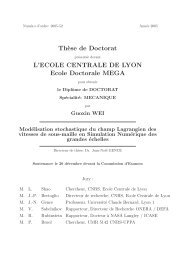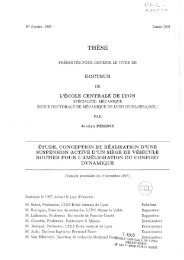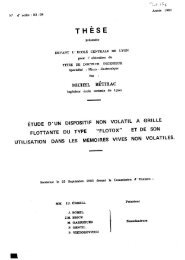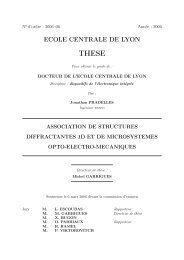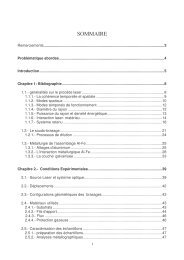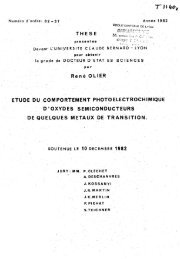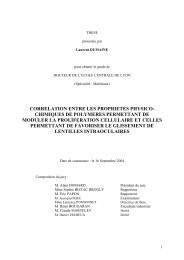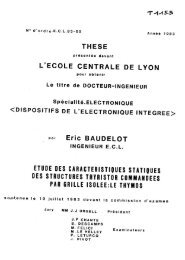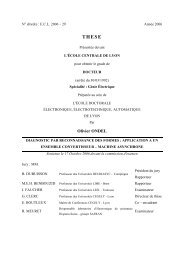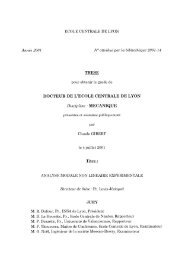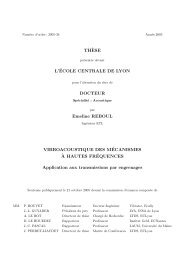Développement de capteurs à fibre optique basés sur la résonance ...
Développement de capteurs à fibre optique basés sur la résonance ...
Développement de capteurs à fibre optique basés sur la résonance ...
Create successful ePaper yourself
Turn your PDF publications into a flip-book with our unique Google optimized e-Paper software.
Résumé Général (en ang<strong>la</strong>is)<br />
Preface<br />
Developments of the Fiber-Optic Sensors<br />
Based on Surface P<strong>la</strong>smon Resonance<br />
for Physical, Chemical and Biological Detection<br />
It is well known that <strong>sur</strong>face p<strong>la</strong>smon resonance (SPR) of the <strong>sur</strong>face electromagnetic<br />
wave can be used as a sensitive optical probe to the slight variations occurring in the<br />
proximity of the metal/dielectric interface. The prism-based Kretschmann configuration is<br />
traditionally employed to excite and <strong>de</strong>tect the SPR. In 1993, the first fiber-optic based SPR<br />
sensor was realized by R.C.Jorgenson and S.S.Yee and then commercialized by Biacore<br />
Company (Swe<strong>de</strong>n). The SPR fiber-optic sensor offers a number of advantages such as small<br />
size, low cost and feasibility in remote sensing over the bulk Kretschmann system. A simpler<br />
SPR multimo<strong>de</strong> fiber-optic sensor using oblique injection of the collimated monochromatic<br />
light has been <strong>de</strong>veloped at the TSI <strong>la</strong>boratory, Jean Monnet University in Samt-Etienne,<br />
France since 1996. Using silver to support SPR at the light wavelength of 670nm, this fiberoptic<br />
sensor was characterized as a refractometer operating in the in<strong>de</strong>x range of 1.35-1.40.<br />
This dissertation consists of five articles aimed to <strong>de</strong>velop this kind of fiber-optic sensor<br />
for physical, chemical and biological applications. The first article is <strong>de</strong>voted to drop down<br />
the range of mea<strong>sur</strong>able indices in or<strong>de</strong>r to be capable of performing in most practical<br />
chemical and biochemical systems whose refractive indices are 1.33-1.36. The re<strong>la</strong>tions<br />
between the structural and material parameters of the multi<strong>la</strong>yered configuration for the<br />
excitation of SPR at certain wavelength have been theoretically <strong>de</strong>rived. Sol-gel technique is<br />
applied to fabricate the Zirconium acetate over<strong>la</strong>y as thin as some ten nanometers. The<br />
reliability is improved by preventing the oxidation of silver using a self-assembled mono<strong>la</strong>yer<br />
(SAM) of long chain acid thiol. This article has been submitted to Thin Solid Films. Accepted<br />
by Sensors & Actuators A, the spatial variations of the electric field vector during the<br />
propagation of the skew rays in the multimo<strong>de</strong> fiber are investigated in the second article. An<br />
accurate 3D mo<strong>de</strong>l has been established so that the experimental phenomena, which first<br />
<strong>de</strong>monstrate the influences of the po<strong>la</strong>rization direction of the inci<strong>de</strong>nt light with respect to<br />
the input end face of the fiber, can be consistently exp<strong>la</strong>ined. The sensing signals coming<br />
from such as the adsorption of a very thin dielectric <strong>la</strong>yer on metal <strong>sur</strong>face or the slight<br />
variation of the refractive in<strong>de</strong>x in the monitored bulk medium are ready to be quantitatively<br />
4



